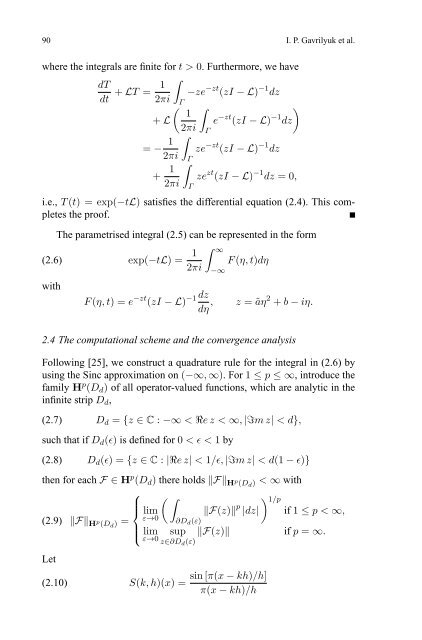H-Matrix approximation for the operator exponential with applications
H-Matrix approximation for the operator exponential with applications
H-Matrix approximation for the operator exponential with applications
You also want an ePaper? Increase the reach of your titles
YUMPU automatically turns print PDFs into web optimized ePapers that Google loves.
90 I. P. Gavrilyuk et al.<br />
where <strong>the</strong> integrals are finite <strong>for</strong> t>0. Fur<strong>the</strong>rmore, we have<br />
dT<br />
dt + LT = 1 ∫<br />
−ze −zt (zI −L) −1 dz<br />
2πi Γ<br />
( ∫<br />
)<br />
1<br />
+ L e −zt (zI −L) −1 dz<br />
2πi Γ<br />
= − 1 ∫<br />
ze −zt (zI −L) −1 dz<br />
2πi Γ<br />
+ 1 ∫<br />
ze zt (zI −L) −1 dz =0,<br />
2πi Γ<br />
i.e., T (t) = exp(−tL) satisfies <strong>the</strong> differential equation (2.4). This completes<br />
<strong>the</strong> proof.<br />
The parametrised integral (2.5) can be represented in <strong>the</strong> <strong>for</strong>m<br />
(2.6) exp(−tL) = 1 ∫ ∞<br />
F (η, t)dη<br />
2πi −∞<br />
<strong>with</strong><br />
F (η, t) =e −zt −1 dz<br />
(zI −L)<br />
dη , z =ãη2 + b − iη.<br />
2.4 The computational scheme and <strong>the</strong> convergence analysis<br />
Following [25], we construct a quadrature rule <strong>for</strong> <strong>the</strong> integral in (2.6) by<br />
using <strong>the</strong> Sinc <strong>approximation</strong> on (−∞, ∞). For1 ≤ p ≤∞, introduce <strong>the</strong><br />
family H p (D d ) of all <strong>operator</strong>-valued functions, which are analytic in <strong>the</strong><br />
infinite strip D d ,<br />
(2.7) D d = {z ∈ C : −∞ < Rez
















